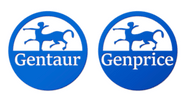Description
SEPT5 Antibody | 14-722 | Gentaur UK, US & Europe Distribution
Host: Rabbit
Reactivity: Human, Mouse, Rat
Homology: N/A
Immunogen: Recombinant fusion protein containing a sequence corresponding to amino acids 1-369 of human SEPT5 (NP_002679.2) .
Research Area: Cell Cycle, Chemokines & Cytokines, Immunology, Neuroscience, Signal Transduction
Tested Application: WB, IHC
Application: WB: 1:500 - 1:2000
IHC: 1:100 - 1:200
Specificiy: N/A
Positive Control 1: Jurkat
Positive Control 2: NIH/3T3
Positive Control 3: Mouse brain
Positive Control 4: Mouse heart
Positive Control 5: Mouse kidney
Positive Control 6: Rat brain
Molecular Weight: Observed: 43kDa
Validation: N/A
Isoform: N/A
Purification: Affinity purification
Clonality: Polyclonal
Clone: N/A
Isotype: IgG
Conjugate: Unconjugated
Physical State: Liquid
Buffer: PBS with 0.02% sodium azide, 50% glycerol, pH7.3.
Concentration: N/A
Storage Condition: Store at -20˚C. Avoid freeze / thaw cycles.
Alternate Name: SEPT5, CDCREL-1, CDCREL1, H5, HCDCREL-1, Peanut-like 1 (Drosophila) , Peanut-like 1, Peanut-like protein 1, Septin 5, Septin-5, CDCREL, PNUTL1
User Note: Optimal dilutions for each application to be determined by the researcher.
BACKGROUND: This gene is a member of the septin gene family of nucleotide binding proteins, originally described in yeast as cell division cycle regulatory proteins. Septins are highly conserved in yeast, Drosophila, and mouse and appear to regulate cytoskeletal organization. Disruption of septin function disturbs cytokinesis and results in large multinucleate or polyploid cells. This gene is mapped to 22q11, the region frequently deleted in DiGeorge and velocardiofacial syndromes. A translocation involving the MLL gene and this gene has also been reported in patients with acute myeloid leukemia. Alternative splicing results in multiple transcript variants. The presence of a non-consensus polyA signal (AACAAT) in this gene also results in read-through transcription into the downstream neighboring gene (GP1BB; platelet glycoprotein Ib) , whereby larger, non-coding transcripts are produced.






